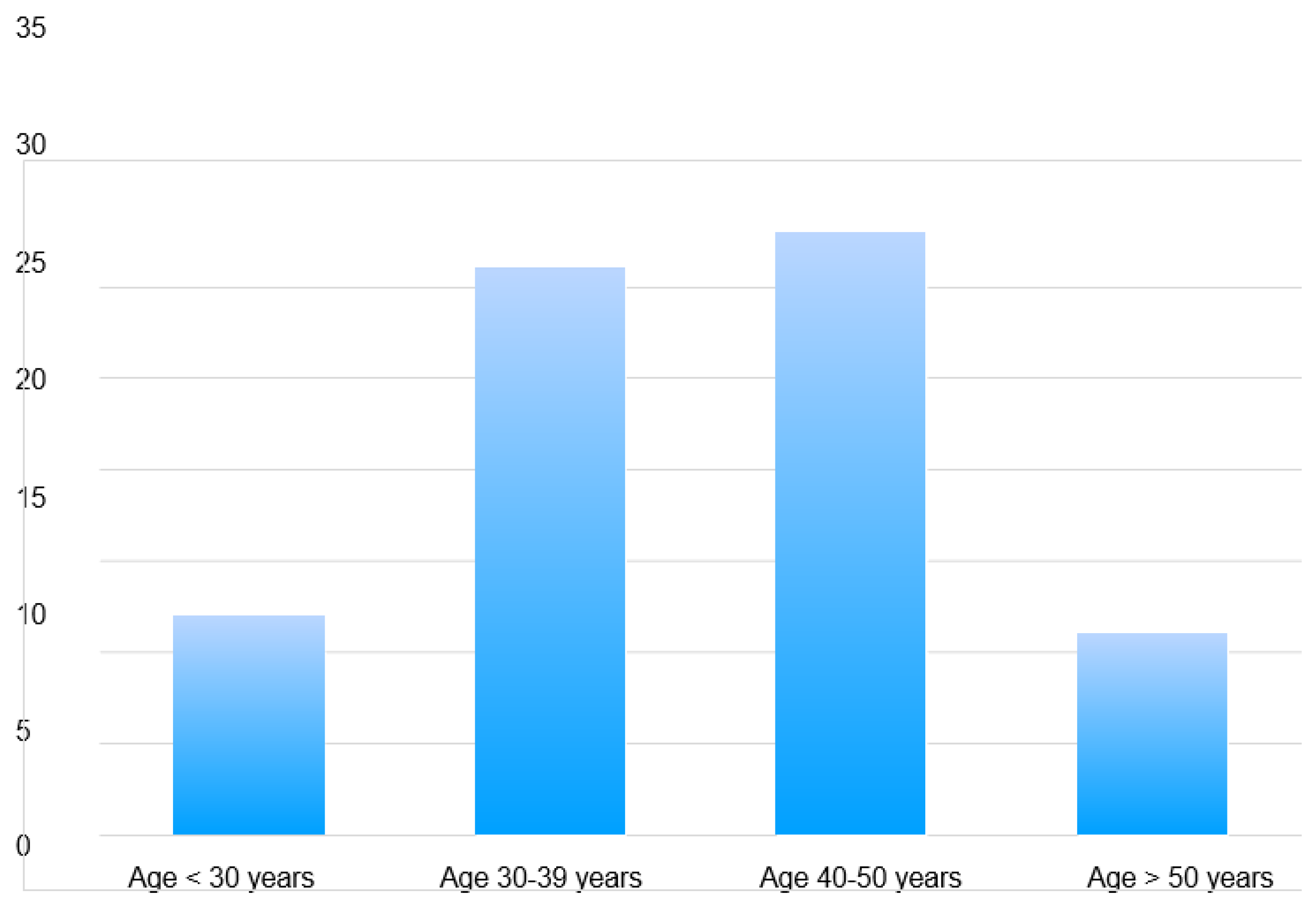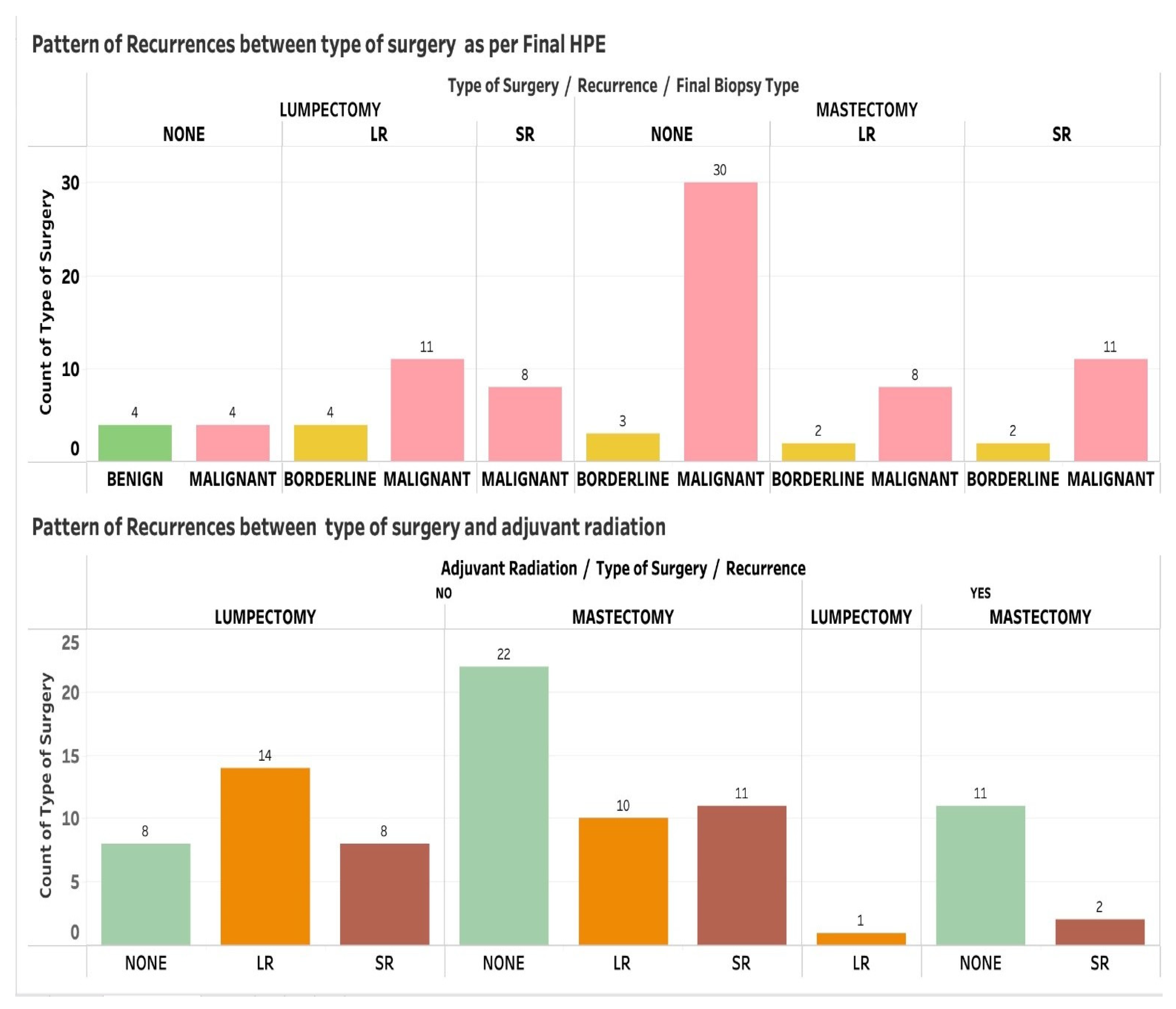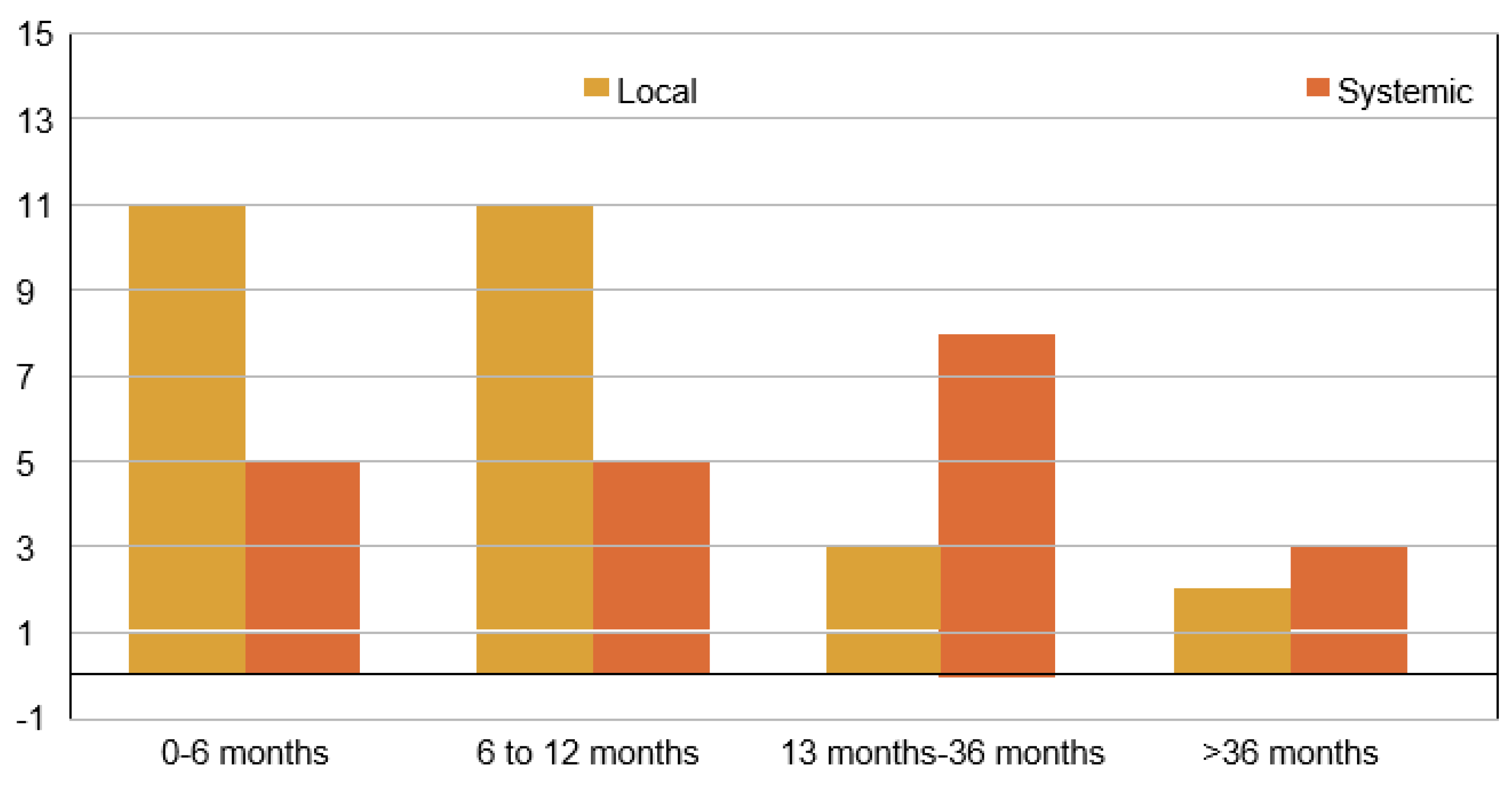Clinico-Pathological Factors Determining Recurrence of Phyllodes Tumors of the Breast: The 25-Year Experience at a Tertiary Cancer Centre
Abstract
1. Introduction
2. Aims and Objectives
3. Materials and Methods
3.1. Study Design and Participants
3.2. Data Collection and Analysis
3.3. Statistical Methods
4. Results
4.1. Demographic and Clinical Characteristics
4.2. Local and Systemic Recurrence
5. Discussion
6. Conclusions
Author Contributions
Funding
Institutional Review Board Statement
Informed Consent Statement
Data Availability Statement
Acknowledgments
Conflicts of Interest
References
- Zhang, Y.; Kleer, C.G. Phyllodes Tumor of the Breast: Histopathologic Features, Differential Diagnosis, and Molecular/Genetic Updates. Arch. Pathol. Lab. Med. 2016, 140, 665–671. [Google Scholar] [CrossRef]
- Nielsen, V.T.; Andreasen, C. Phyllodes tumour of the male breast. Histopathology 1987, 11, 761–762. [Google Scholar] [PubMed]
- Mishra, S.P.; Tiwary, S.K.; Mishra, M.; Khanna, A.K. Phyllodes tumor of breast: A review article. ISRN Surg. 2013, 2013, 361469. [Google Scholar] [CrossRef] [PubMed]
- Adesoye, T.; Neuman, H.B.; Wilke, L.G.; Schumacher, J.R.; Steiman, J.; Greenberg, C.C. Current Trends in the Management of Phyllodes Tumors of the Breast. Ann. Surg. Oncol. 2016, 23, 3199–3205. [Google Scholar] [CrossRef] [PubMed]
- Mitus, J.; Blecharz, P.; Jakubowicz, J.; Reinfuss, M.; Walasek, T.; Wysocki, W. Phyllodes tumors of the breast. The treatment results for 340 patients from a single cancer centre. Breast 2019, 43, 85–90. [Google Scholar] [CrossRef]
- Gullett, N.P.; Rizzo, M.; Johnstone, P.A.S. National surgical patterns of care for primary surgery and axillary staging of phyllodes tumors. Breast J. 2009, 15, 41–44. [Google Scholar] [CrossRef]
- Testori, A.; Meroni, S.; Errico, V.; Travaglini, R.; Voulaz, E.; Alloisio, M. Huge malignant phyllodes breast tumor: A real entity in a new era of early breast cancer. World J. Surg. Oncol. 2015, 13, 81. [Google Scholar] [CrossRef]
- Atalay, C.; Kınaş, V.; Çelebioğlu, S. Analysis of patients with phyllodes tumor of the breast. Ulus. Cerrahi Derg. 2014, 30, 129–132. [Google Scholar]
- Kim, S.; Kim, J.Y.; Kim, D.H.; Jung, W.H.; Koo, J.S. Analysis of phyllodes tumor recurrence according to the histologic grade. Breast Cancer Res. Treat. 2013, 141, 353–363. [Google Scholar] [CrossRef]
- Barrio, A.V.; Clark, B.D.; Goldberg, J.I.; Hoque, L.W.; Bernik, S.F.; Flynn, L.W.; Susnik, B.; Giri, D.; Polo, K.; Patil, S.; et al. Clinicopathologic features and long-term outcomes of 293 phyllodes tumors of the breast. Ann. Surg. Oncol. 2007, 14, 2961–2970. [Google Scholar] [CrossRef]
- Tan, B.Y.; Acs, G.; Apple, S.K.; Badve, S.; Bleiweiss, I.J.; Brogi, E.; Calvo, J.P.; Dabbs, D.J.; Ellis, I.O.; Eusebi, V.; et al. Phyllodes tumours of the breast: A consensus review. Histopathology 2016, 68, 5–21. [Google Scholar] [CrossRef] [PubMed]
- Pezner, R.D.; Schultheiss, T.E.; Paz, I.B. Malignant phyllodes tumor of the breast: Local control rates with surgery alone. Int. J. Radiat. Oncol. Biol. Phys. 2008, 71, 710–713. [Google Scholar] [CrossRef] [PubMed]
- Ward, S.T.; Jewkes, A.J.; Jones, B.G.; Chaudhri, S.; Hejmadi, R.K.; Ismail, T.; Hallissey, M.T. The sensitivity of needle core biopsy in combination with other investigations for the diagnosis of phyllodes tumours of the breast. Int. J. Surg. 2012, 10, 527–531. [Google Scholar] [CrossRef] [PubMed]
- Gatta, G.; Iaselli, F.; Parlato, V.; Di Grezia, G.; Grassi, R.; Rotondo, A. Differential diagnosis between fibroadenoma, giant fibroadenoma and phyllodes tumour: Sonographic features and core needle biopsy. Radiol. Med. 2011, 116, 905–918. [Google Scholar] [CrossRef] [PubMed]
- Yom, C.K.; Han, W.; Kim, S.W.; Park, S.Y.; Park, I.A.; Noh, D.Y. Reappraisal of conventional risk stratification for local recurrence based on clinical outcomes in 285 resected phyllodes tumors of the breast. Ann. Surg. Oncol. 2015, 22, 2912–2918. [Google Scholar] [CrossRef] [PubMed]
- Shaaban, M.; Barthelmes, L. Benign phyllodes tumours of the breast: (Over) treatment of margins—A literature review. Eur. J. Surg. Oncol. 2017, 43, 1186–1190. [Google Scholar] [CrossRef]
- Salvadori, B.; Cusumano, F.; Del Bo, R.; Delledonne, V.; Grassi, M.; Rovini, D.; Saccozzi, R.; Andreola, S.; Clemente, C. Surgical treatment of phyllodes tumors of the breast. Cancer 1989, 63, 2532–2536. [Google Scholar] [CrossRef]
- Tan, P.H.; Thike, A.A.; Tan, W.J.; Thu, M.M.; Busmanis, I.; Li, H.; Chay, W.Y.; Tan, M.H. Phyllodes Tumour Network Singapore. Predicting clinical behaviour of breast phyllodes tumours: A nomogram based on histological criteria and surgical margins. J. Clin. Pathol. 2012, 65, 69–76. [Google Scholar] [CrossRef]
- Lin, C.C.; Chang, H.W.; Lin, C.Y.; Chiu, C.F.; Yeh, S.P. The clinical features and prognosis of phyllodes tumors: A single institution experience in Taiwan. Int. J. Clin. Oncol. 2013, 18, 614–620. [Google Scholar] [CrossRef]
- Teo, J.Y.; Cheong, C.S.; Wong, C.Y. Low local recurrence rates in young Asian patients with phyllodes tumours: Less is more. ANZ. J. Surg. 2012, 82, 325–328. [Google Scholar] [CrossRef]
- Tan, H.; Zhang, S.; Liu, H.; Peng, W.; Li, R.; Gu, Y.; Wang, X.; Mao, J.; Shen, X. Imaging findings in phyllodes tumors of the breast. Eur. J. Radiol. 2012, 81, 62–69. [Google Scholar] [CrossRef] [PubMed]
- Tan, P.H.; Ellis, I.; Allison, K.; Brogi, E.; Fox, S.B.; Lakhani, S.; Lazar, A.J.; Morris, E.A.; Sahin, A.; Salgado, R.; et al. The 2019 World Health Organization classification of tumours of the breast. Histopathology 2020, 77, 181–185. [Google Scholar] [CrossRef]
- Acar, T.; Tarcan, E.; Hacıyanlı, M.; Kamer, E.; Peşkersoy, M.; Yiğit, S.; Gür, Ö.; Cin, N.; Sarı, A.A.; Tatar, F. How to approach phyllodes tumors of the breast? Ulus. Cerrahi Derg. 2015, 31, 197–201. [Google Scholar] [CrossRef] [PubMed]
- Spitaleri, G.; Toesca, A.; Botteri, E.; Bottiglieri, L.; Rotmensz, N.; Boselli, S.; Sangalli, C.; Catania, C.; Toffalorio, F.; Noberasco, C.; et al. Breast phyllodes tumor: A review of literature and a single center retrospective series analysis. Crit. Rev. Oncol. Hematol. 2013, 88, 427–436. [Google Scholar] [CrossRef]
- Gnerlich, J.L.; Williams, R.T.; Yao, K.; Jaskowiak, N.; Kulkarni, S.A. Utilization of radiotherapy for malignant phyllodes tumors: Analysis of the National Cancer Data Base, 1998–2009. Ann. Surg. Oncol. 2014, 21, 1222–1230. [Google Scholar] [CrossRef] [PubMed]
- Ibreaheem, M.H.; Naguib, S.; Gamal, M.; Boutrus, R.; Gomaa, M.M.M.; Talaat, O. Phyllodes Tumors of the Breast (the Egyptian Experience). Indian J. Surg. Oncol. 2020, 11, 423–432. [Google Scholar] [CrossRef] [PubMed]
- Kim, Y.J.; Kim, K. Radiation therapy for malignant phyllodes tumor of the breast: An analysis of SEER data. Breast 2017, 32, 26–32. [Google Scholar] [CrossRef]
- Shah, S.; Rachmat, R.; Enyioma, S.; Ghose, A.; Revythis, A.; Boussios, S. BRCA Mutations in Prostate Cancer: Assessment, Implications and Treatment Considerations. Int. J. Mol. Sci. 2021, 22, 12628. [Google Scholar] [CrossRef]
- Kim, J.W.; Kang, H.E.; Choi, J.; Yun, S.G.; Jung, S.P.; Bae, S.Y.; You, J.Y.; Choi, Y.J.; Kim, Y.H.; Park, K.H. Genomic Signatures from Clinical Tumor Sequencing in Patients with Breast Cancer Having Germline BRCA1/2 Mutation. Cancer Res. Treat. 2023, 55, 155–166. [Google Scholar] [CrossRef]
- Shah, S.; Cheung, A.; Kutka, M.; Sheriff, M.; Boussios, S. Epithelial Ovarian Cancer: Providing Evidence of Predisposition Genes. Int. J. Environ. Res. Public Health 2022, 19, 8113. [Google Scholar] [CrossRef]
- Boussios, S.; Rassy, E.; Moschetta, M.; Ghose, A.; Adeleke, S.; Sanchez, E.; Sheriff, M.; Chargari, C.; Pavlidis, N. BRCA Mutations in Ovarian and Prostate Cancer: Bench to Bedside. Cancers 2022, 14, 3888. [Google Scholar] [CrossRef] [PubMed]



| VARIABLES | Recurrence YES | Recurrence NO | p Value (Univariate Analysis) | p Value (Multivariate Logistic Regression Analysis) | |||
|---|---|---|---|---|---|---|---|
| N | % | N | % | ||||
| Biopsy | BENIGN | 07 | 15.22 | 09 | 21.95 | 0.956 | 0.160 |
| MALIGNANT | 39 | 84.78 | 32 | 78.05 | |||
| YES | 21 | 45.65 | 22 | 53.66 | |||
| Age > 40 years | NO | 25 | 54.35 | 19 | 46.34 | 0.967 | 0.398 |
| BENIGN | 0 | 0.00 | 4 | 9.76 | |||
| BODERLINE | 08 | 17.39 | 03 | 7.32 | |||
| Final Tumor grade | MALIGNANT | 38 | 82.61 | 34 | 82.93 | 0.398 | 0.093 |
| LEFT | 14 | 30.43 | 18 | 43.90 | |||
| Side | RIGHT | 32 | 69.57 | 23 | 56.10 | 0.792 | 0.444 |
| LUMPECTOMY | 23 | 50.00 | 08 | 19.51 | |||
| Surgery | MASTECTOMY | 23 | 50.00 | 33 | 80.49 | 0.0067 | 0.008 |
| YES | 03 | 6.52 | 11 | 26.83 | |||
| Adjuvant Radiotherapy | NO | 43 | 93.48 | 30 | 73.17 | 0.157 | 0.041 |
| YES | 16 | 34.78 | 15 | 36.59 | |||
| Size > 10cm | NO | 30 | 65.22 | 26 | 63.41 | 0.999 | 0.766 |
| VARIABLES | Recurrence YES | Recurrence NO | p Value (Local Recurrence) | p Value (Systemic Recurrence) | |||
|---|---|---|---|---|---|---|---|
| N | % | N | % | ||||
| BENIGN | 07 | 15.22 | 09 | 21.95 | |||
| Biopsy | MALIGNANT | 39 | 84.78 | 32 | 78.05 | 0.808 | 0.049 |
| YES | 21 | 45.65 | 22 | 53.66 | |||
| Age > 40 years | NO | 25 | 54.35 | 19 | 46.34 | 0.294 | 0.206 |
| BENIGN | 0 | 0.00 | 4 | 9.76 | |||
| BODERLINE | 08 | 17.39 | 03 | 7.32 | |||
| Final Tumor grade | MALIGNANT | 38 | 82.61 | 34 | 82.93 | 0.188 | 0.478 |
| LEFT | 14 | 30.43 | 18 | 43.90 | |||
| Side | RIGHT | 32 | 69.57 | 23 | 56.10 | 0.278 | 0.951 |
| LUMPECTOMY | 23 | 50.00 | 08 | 19.51 | |||
| Surgery | MASTECTOMY | 23 | 50.00 | 33 | 80.49 | 0.007 | 0.083 |
| YES | 03 | 6.52 | 11 | 26.83 | |||
| Adjuvant Radiotherapy | NO | 43 | 93.48 | 30 | 73.17 | 0.097 | 0.126 |
| YES | 16 | 34.78 | 15 | 36.59 | |||
| Size > 10 cm | NO | 30 | 65.22 | 26 | 63.41 | 0.917 | 0.425 |
Disclaimer/Publisher’s Note: The statements, opinions and data contained in all publications are solely those of the individual author(s) and contributor(s) and not of MDPI and/or the editor(s). MDPI and/or the editor(s) disclaim responsibility for any injury to people or property resulting from any ideas, methods, instructions or products referred to in the content. |
© 2023 by the authors. Licensee MDPI, Basel, Switzerland. This article is an open access article distributed under the terms and conditions of the Creative Commons Attribution (CC BY) license (https://creativecommons.org/licenses/by/4.0/).
Share and Cite
Sain, B.; Gupta, A.; Ghose, A.; Halder, S.; Mukherjee, V.; Bhattacharya, S.; Mondal, R.R.; Sen, A.N.; Saha, B.; Roy, S.; et al. Clinico-Pathological Factors Determining Recurrence of Phyllodes Tumors of the Breast: The 25-Year Experience at a Tertiary Cancer Centre. J. Pers. Med. 2023, 13, 866. https://doi.org/10.3390/jpm13050866
Sain B, Gupta A, Ghose A, Halder S, Mukherjee V, Bhattacharya S, Mondal RR, Sen AN, Saha B, Roy S, et al. Clinico-Pathological Factors Determining Recurrence of Phyllodes Tumors of the Breast: The 25-Year Experience at a Tertiary Cancer Centre. Journal of Personalized Medicine. 2023; 13(5):866. https://doi.org/10.3390/jpm13050866
Chicago/Turabian StyleSain, Baijaeek, Arnab Gupta, Aruni Ghose, Sudip Halder, Vishal Mukherjee, Samir Bhattacharya, Radha Raman Mondal, Aditya Narayan Sen, Bijan Saha, Shravasti Roy, and et al. 2023. "Clinico-Pathological Factors Determining Recurrence of Phyllodes Tumors of the Breast: The 25-Year Experience at a Tertiary Cancer Centre" Journal of Personalized Medicine 13, no. 5: 866. https://doi.org/10.3390/jpm13050866
APA StyleSain, B., Gupta, A., Ghose, A., Halder, S., Mukherjee, V., Bhattacharya, S., Mondal, R. R., Sen, A. N., Saha, B., Roy, S., & Boussios, S. (2023). Clinico-Pathological Factors Determining Recurrence of Phyllodes Tumors of the Breast: The 25-Year Experience at a Tertiary Cancer Centre. Journal of Personalized Medicine, 13(5), 866. https://doi.org/10.3390/jpm13050866







